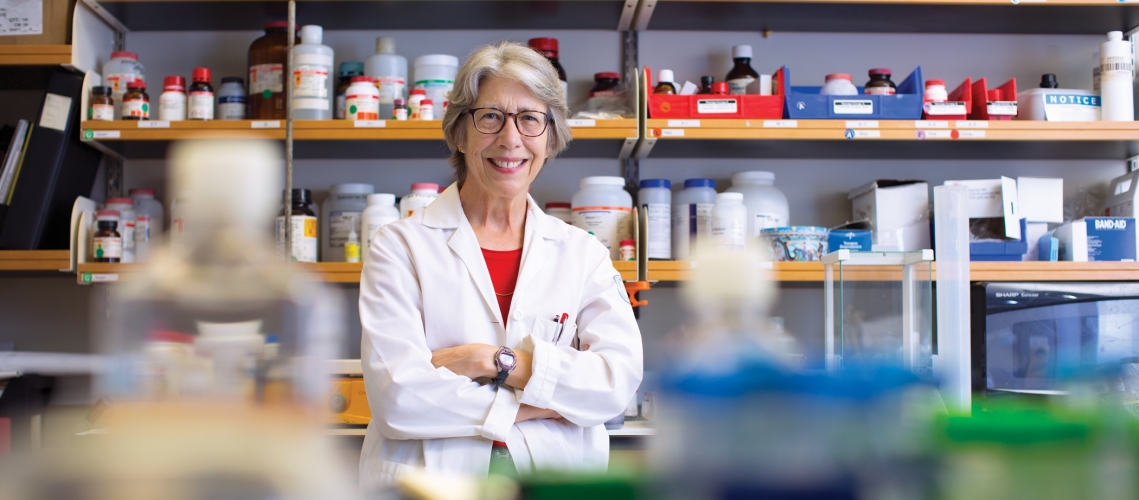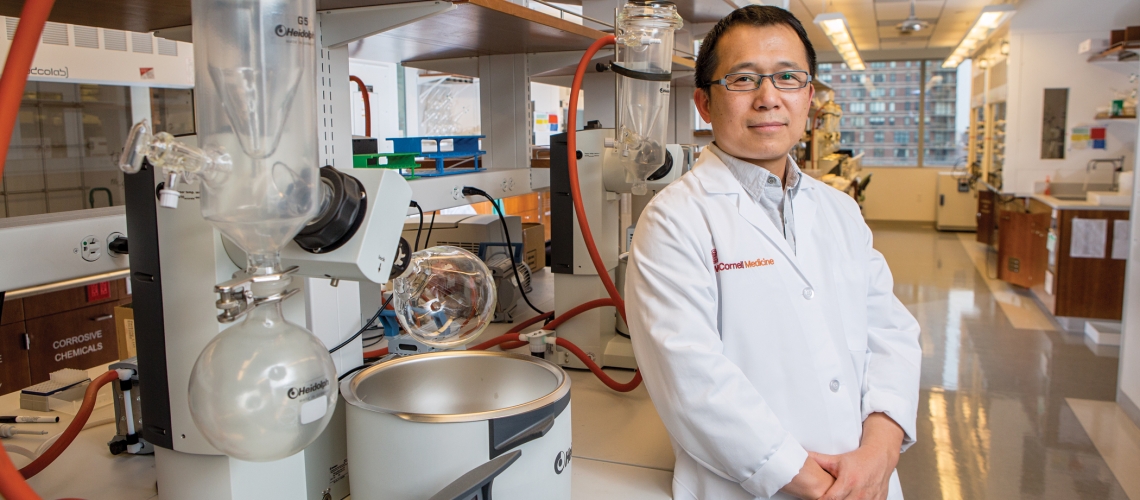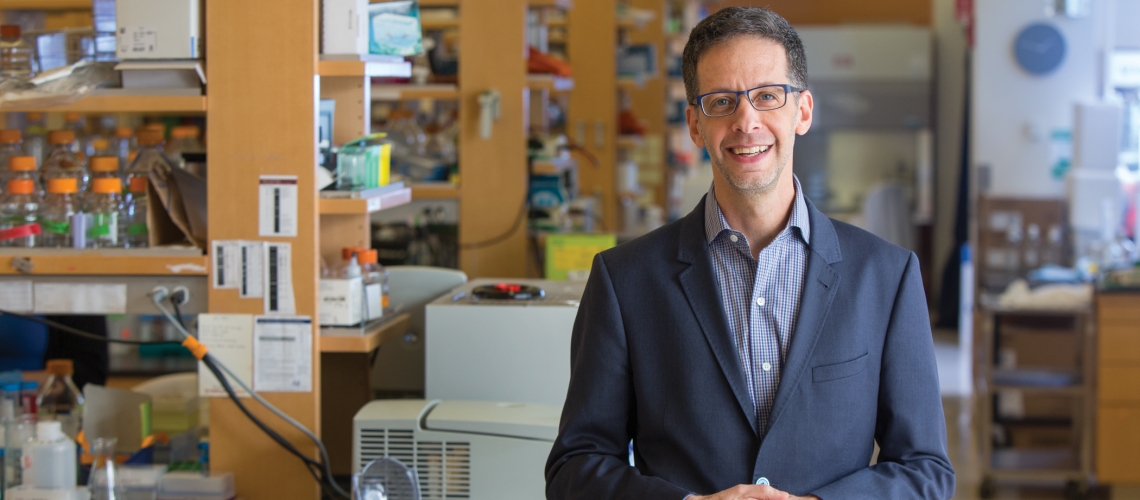As Dr. Augustine M.K. Choi, the Stephen and Suzanne Weiss Dean of Weill Cornell Medicine, sees it, the programs that Weill Cornell Medicine has established in recent years to nurture the evolution of faculty research into new patient therapies aren’t just innovative. Together, he says, they add up to something unique in the history of academia. “For the first time, there is a fully funded, fully staffed, unbroken pathway from an idea in a professor’s head to proving it works in people,” he says. “This is not happening anywhere else in the world.”
One of those programs, the nonprofit Tri-Institutional Therapeutics Discovery Institute, fosters early stage drug development by bringing Weill Cornell Medicine investigators and their colleagues at neighboring institutions Memorial Sloan Kettering Cancer Center and The Rockefeller University together with medicinal chemists from Japan’s Takeda Pharmaceutical Company. “The true value of our faculty’s innovative research isn’t revealed until it gets into the human realm,” says its inaugural Sanders director, Dr. Michael Foley. “Being entrepreneurial and moving these projects forward are where we really begin to shine.” At Weill Cornell Medicine, he says, “our professors have more of these tools at their disposal than at any other academic institution on the planet.”
Those tools include a further step in the drug development pipeline: a for-profit company, Bridge Medicines, that was founded in 2016 — three years after the Tri-I TDI. A collaboration by the TDI partners and two investment firms, Bridge Medicines furthers development of drugs that have been nurtured by TDI and have commercial potential. “We take a molecule from the time it first shows potential at TDI as a drug candidate and do the work required to initiate clinical trials,” explains its CEO, Dr. William Polvino, a pharma industry veteran trained in internal medicine. “A lot of those activities go on behind the scenes and are not particularly glamorous—but oftentimes it’s where things stop, because getting to the point of clinical studies requires time, money and expertise.”
Both TDI and Bridge Medicines are innovative approaches to closing the proverbial “development gap.” Also known as the “valley of death,” it’s the space where too many promising clinical advances languish, stuck between the initial idea and the concrete results that would attract funding from granting agencies or outside investors. But programs like TDI and Bridge Medicines have another benefit as well: they nurture the entrepreneurial, can-do spirit that is growing among researchers at Weill Cornell Medicine and its peer institutions. “The entrepreneurial ecosystem we’re building here is critical for recruitment and retention,” notes Larry Schlossman, Weill Cornell Medicine’s managing director of BioPharma Alliances and Research Collaborations. “When new faculty are being recruited, the department chair often asks me to meet with the potential recruit, because he or she has asked what programs and infrastructure we have to support entrepreneurship. They’re interested in developing new technologies and starting companies—and only those institutions that offer dedicated resources are going to be able to compete.”
Opened in 2014, the BioPharma Alliances and Research Collaborations office was founded specifically to catalyze business development opportunities around the work of Weill Cornell Medicine investigators, which includes designing the value proposition of faculty and student work, crafting and marketing collaboration proposals to industry, generating interest from outside investors, and negotiating high-value research alliance agreements. It has proven critical to generating interest from outside investors and significant increases in research funding from industry. The office’s efforts include launching the Weill Cornell Medicine BioVenture e-Lab (formerly known as the Dean’s Entrepreneurship Lab), which offers resources and training for students and faculty interested in translating their research to the commercial sphere—a cadre whose number are growing. A related, university-wide entity, the Center for Technology Licensing (CTL), has a New York City office, run by Dr. Brian Kelly that also plays a significant role in Weill Cornell Medicine’s entrepreneurial ecosystem. CTL works with Weill Cornell Medicine faculty to identify and manage their inventions, filing patents on those ideas and marketing and licensing them to potential industry partners. In many instances, these inventions can be the genesis of start-up companies, with which CTL negotiates the foundational intellectual property agreements. “The spirit at Weill Cornell is phenomenal,” Dr. Polvino says. “I see a lot of energy, excitement and interest. The ideas and momentum here are great.”
In 2014, Weill Cornell Medicine established a funding stream to help propel the development of promising ideas. Known as the Daedalus Fund for Innovation—named for an ingenious inventor from Greek myth—it supports early stage research projects that have significant commercial potential, offering awards of as much as $300,000. Schlossman emphasizes that Daedalus is not a grant-giving entity, but rather a business-focused seed fund for technology development; its goal, he says, is to establish sufficient proof of concept to attract outside investment, getting projects to the point where they’re “partnership ready.” “We’re trying to build a pipeline,” he says. “The attrition rate in pharma is formidable and sobering, because almost everything fails in clinical trials. So you’ve got to get technologies out of the lab and into a commercial setting, where they can be developed with the focus and rigor that only industry can provide. The more you increase your shots on goal, the greater the odds that something will succeed.” Taken together, the various programs of Weill Cornell Medicine’s entrepreneurial ecosystem have already nurtured the work of hundreds of faculty and students. Board chairman Jessica Bibliowicz points out that these early successes—including projects spearheaded by the investigators who are featured on the following pages—have inspired similar efforts at other institutions, including Stanford, Oxford and Johns Hopkins. “The world is waking up to this; it’s the hottest thing,” she says. “It’s very gratifying to see others embrace this model.”
This story first appeared in Weill Cornell Medicine, Vol. 17. No. 1







